The New York Times has reported an increase in the number of people working remotely. A larger proportion of the workforce now work at home or outside of the office. In this blog, we will discuss the many benefits of telecommuting and how managers can monitor the engagement of flexi-working employees.

👉 Check out our guide on how to support your remote workforce
1. Improved Mental Health
Research has showed that employees experience up to 25% less stress whilst working from home. Connect Solutions, the private cloud solutions provider for Adobe Connect, reported that over 50% of their employees disclosed less work-related stress. Furthermore, in 2014, PGi concluded that 80% of remote workers agreed that telecommuting reduced their stress levels. This reduces burnouts and improves employee mental health.
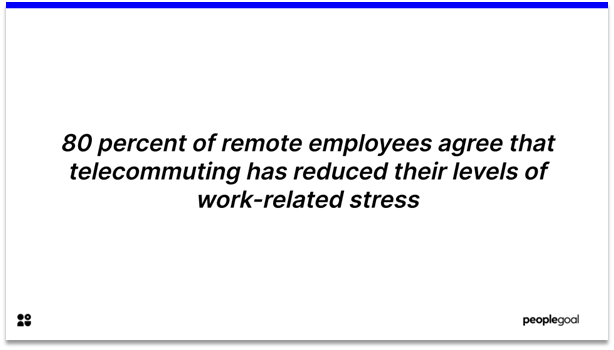
👉 Click here for 10 ways to reduce workplace stress
2. Enhanced Work-life balance
Remote working employees enjoy a better work-life balance as their work hours become more flexible. This further gives employees a greater sense of ownership, control, and responsibility in their working life. Some associate this with greater freedom and a move away from micromanagement.
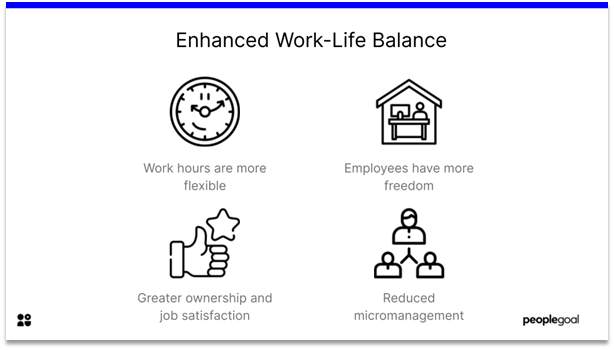
3. Reduced carbon footprint
Remote working offers a simple, easy and cost-effective solution to help organizations reduce their carbon footprint. This is because there are fewer employees commuting to work and there are fewer devices running onsite. This subsequently reduces energy consumption and greenhouse gas emissions. in 2012, Dell pledged to reduce their emissions by making 50% of their workforce remote by 2020. In 2014, it was reported that the program has reduced greenhouse gas emissions by 6,700 metric tonnes. Align your telecommuting practices with your company mission, values and culture.
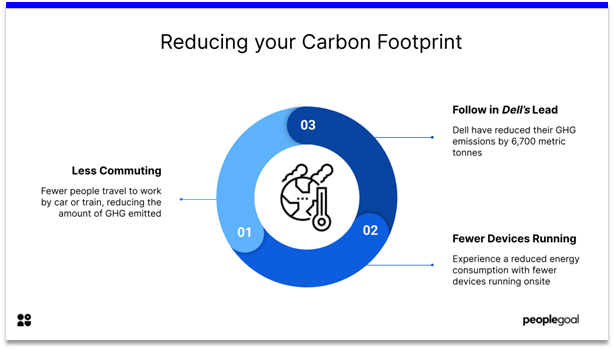
👉 Click here for more information on sustainability in the workplace
4. Multi-generational Benefits
The benefits of remote working are both short-term and long-term. By 2025, around 75% of the workforce will be millenials, many of whom have learned to value telecommuting through the coronavirus pandemic. Equally, older generations can profit from remote working as life expectancy is on the rise and people face an increased cost of living. Working from home creates an equal opportunity for all to obtain a regular income.
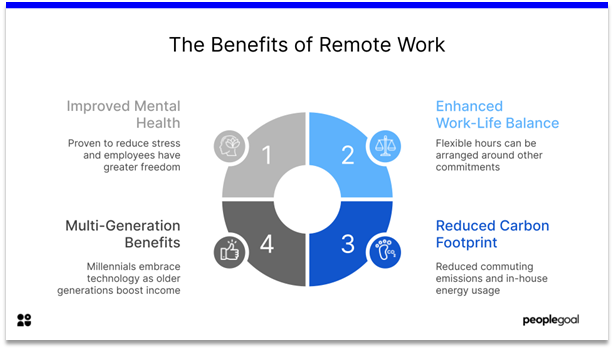
How do you maximize remote employee engagement?
As rates of remote working continue to increase year after year, it is important to sustain employee engagement levels amongst your telecommuting workforce. Managers are often concerned that owrking from home can isolate employees which can have consequences for an individual and their team’s performance and productivity, and overall engagement.
A recent study conducted by [Slack]((https://slack.com/intl/en-in/blog/transformation/trust-tools-and-teamwork-what-workers-want) found that 85% of workers would like to feel closer to their remote colleagues. It is therefore important to boost remote worker engagement and this can be done in the following ways:
- Prioritize Communication between all members of your team
- Show Appreciation for all of your employees
- Increase particpation
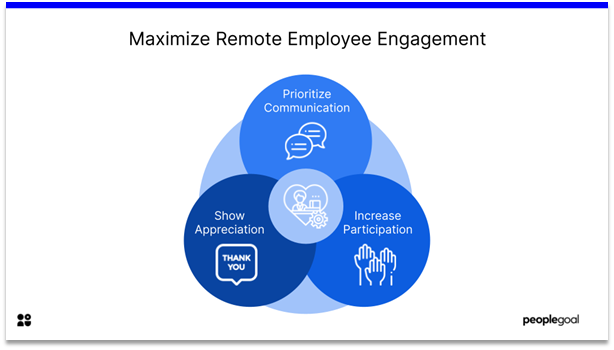
Prioritize Communication
Good communication is integral to employee performance. It is vital to keep in regular contact with remote employees to increase engagement. Below we suggest a couple of proven strategies:
- Virtual face-to-face meetings e.g. through Skype, Google Hangouts, Microsoft Teams, Zoom, Go-To-Meeting
- Invest in communication tools e.g. Slack, Yammer
- Build communication skills through training and workshops
- Financial Assistance to help build a productive workspace from the home
- Focus on remote onboarding
- Extracurricular activities
- Offer real responsibility and accountability to all job roles
Communication is an essential skill in the workplace and plays a crucial role in employee engagement. A recent study conducted by HBR shows that remote workers hugely value regular communication with their colleagues and management. The best managers are good listeners, fair in judgement, and communicate respect, trust and interest, both in-office and remotely.
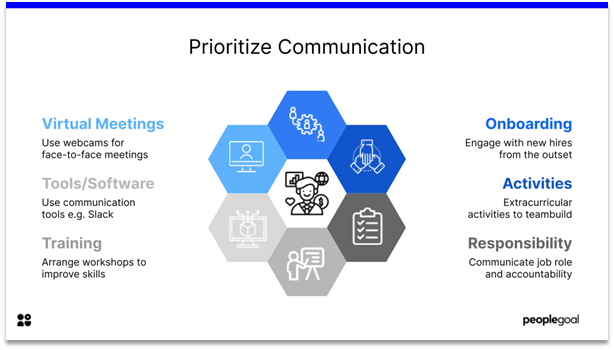
👉 Read here to learn more about the difference between formal and informal communication
Show Appreciation
Feedback and recognition are an important component of your company culture and have a significant effect on employee engagement. Virtual appreciation should be a priority for your team. Consider investing in a simple feedback and recognition tool to encourage appreciation between colleagues.
One way to show appreciation for your remote colleagues is to assist them in building a productive workspace from home. Adapt your rewards packages to gift a desk, a chair, a computer, office supplies or even a broadband subsidy. This will demonstrate to your employees that you value their input into the organization.
Equally, when remote employees visit the office, ensure that they feel welcome and appreciated. Organise team meetings or lunches to ensure that colleagues remain connected and engaged with each other.
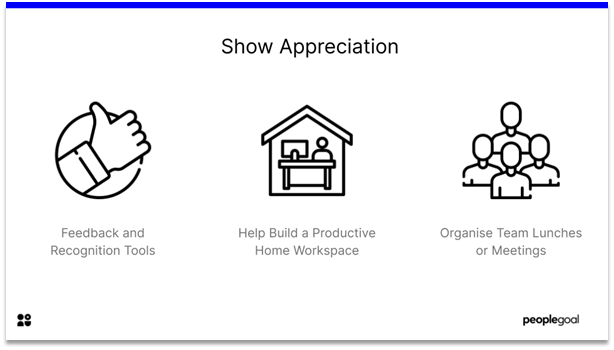
Increase Participation
In addition to improving communication and showing appreciation, you can improve remote employee engagement by increasing participation. This can be done in 3 key areas:
- Onboarding
- Out of Work Activities
- Responsibility and Accountability
Use the onboarding period of new hires to maximize employee engagement. Throughout the first few days and weeks, ensure that new employees have met their colleagues and built a strong network. This ensures that employees have the means, tools, and desire to engage with their co-workers from the outset.
Managers can also boost engagement and motivation through extracurricular activities that include remote employees. Activities include creating fantasy leagues, online gaming, or even just creating a team group chat.
Finally, remote employees are more likely to feel engaged if they understand the importance of their roles. Ensure remote employees are assigned tasks with real responsibility, risk and accountability. Employees will feel valued and fulfilled from their job role, perhaps seeking further career progression with your organization.
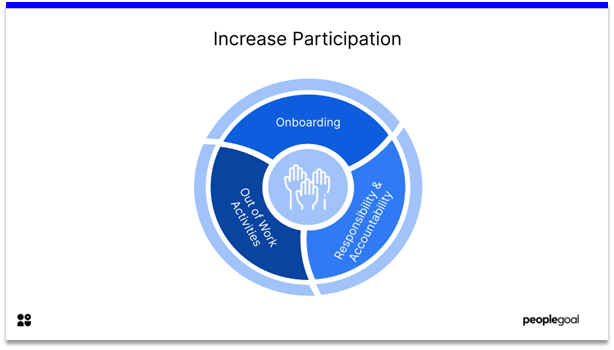
👉 Take a look at our guide on how to make remote onboarding successful
How can you measure remote employee engagement?
Measuring employee engagement is crucial to understand how well your organization is operating. It is possible to do this through eNPS or Pulse Surveys with PeopleGoal.
1. eNPS
eNPS (Employee Net Promoter Score) is a two-question survey which asks employees how likely they would be to reccomend working at your organization. This provides employers with a performance rating that they can use to understand how employees feel about the company, whether this be positive or negative.
2. Pulse Surveys
Pulse surveys are short, multiple-choice questionnaires sent to employees to ask about their engagement. They are quick and easy to complete and helps HR departments identify in which areas the company is performing well, and where employees would appreciate more support.

Our Concluding Thoughts
Overall, employee engagement is crucial to an individual’s performance and productivity. Organizations should focus on this particularly as remote working becomes the norm and more people are hired remotely.
PeopleGoal can support your organization and boost your remote workers’ engagement with our diverse array of apps. We offer engagement solutions that can be customized to suit your workflows and company culture.
Ready to 3x Your Teams' Performance?
Use the best performance management software to align goals, track progress, and boost employee engagement.

